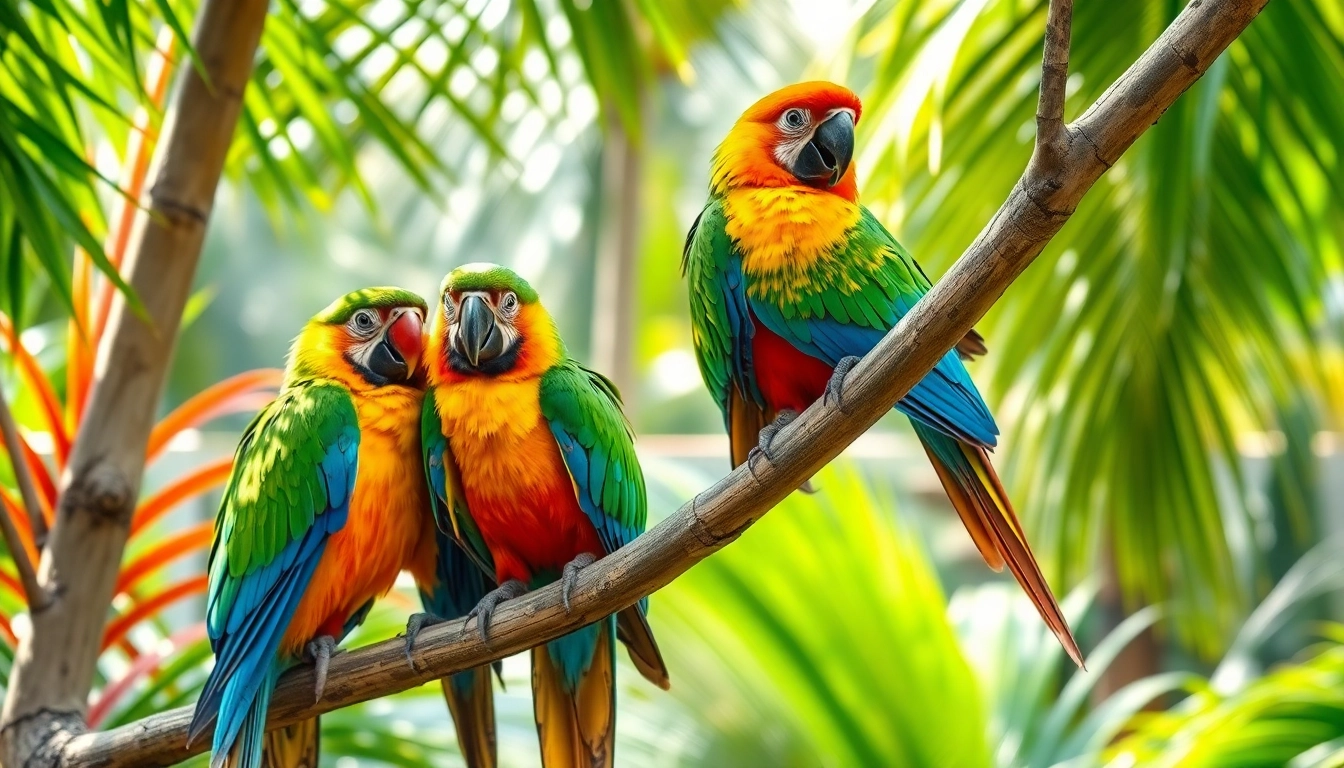Introduction to Parrots: Nature’s Intelligent Avians
Parrots are among the most captivating and intelligent bird species in the world, renowned for their vibrant plumage, remarkable vocal abilities, and complex social behaviors. These avian wonders inhabit diverse environments, predominantly within tropical and subtropical regions, where they play vital roles in ecosystem health. Their natural habitats range from lush rainforests to savannahs, each supporting a unique array of parrot species adapted to specific ecological niches. Understanding these fascinating creatures requires a deep appreciation for their biological traits, behavioral patterns, and their importance within the broader environmental context.
For bird enthusiasts and conservation advocates alike, parrots represent not only a marvel of evolution but also a symbol of biodiversity preservation. Their intelligence and trainability have made them popular as pets, yet their wild populations face significant threats. Consequently, exploring the intricate world of parrots—covering their physical features, behaviors, and conservation challenges—is essential for fostering informed appreciation and effective protection efforts.
Understanding Parrot Species and Their Habitats
The parrot family, scientifically known as Psittacidae, encompasses over 390 species, spanning a wide range of sizes, colors, and ecological adaptations. From the small lovebird to the majestic macaw, each species has evolved specific traits suited to its environment. Tropical forests of South America, Africa, and Australasia serve as primary habitats, offering the trees, cavities, and food resources essential for survival.
Notable species such as the Scarlet Macaw and Blue-and-Gold Macaw thrive in dense, humid forests, relying on their strong beaks to crack open nuts and seeds. Conversely, species like the Monk Parakeet adapt to urban settings, often nesting in human structures. The diversity of habitats reflects the parrot’s adaptability but also underscores their vulnerability when habitats are altered or destroyed by deforestation and urbanization.
The Ecological Importance of Parrots in Tropical Ecosystems
Parrots play a crucial role in maintaining the health and stability of their ecosystems. They are seed dispersers, facilitating the regeneration of forests by spreading seeds over wide areas through their feeding activities. Their consumption of fruits, nuts, and berries leads to effective distribution, which promotes plant diversity and forest regeneration.
Additionally, parrots contribute to nutrient cycling within their habitats. By foraging in the canopy and nesting in trees, they influence habitat dynamics and create opportunities for other species. Their presence is often an indicator of ecosystem health; declines in parrot populations may signal broader environmental issues, including habitat degradation and climate change impacts.
Historical Significance and Cultural Symbolism of Parrots
Throughout history, parrots have captured human imagination and symbolism across cultures. Ancient civilizations, such as the Egyptians and Mayans, depicted parrots in art, symbolizing beauty, communication, and divine messages. In many societies, parrots are considered symbols of freedom and intelligence due to their ability to mimic human speech.
In contemporary culture, parrots continue to serve as motifs in art, literature, and popular media, underscoring their charismatic appeal. Their vibrant colors and mimicry abilities have also made them symbols of tropical tourism and exotic pet trade, influencing both cultural perceptions and conservation efforts worldwide.
Physical Features and Behaviors of Parrots
Distinctive Colors, Beak Structures, and Adaptive Traits
Parrots are most renowned for their vivid plumage, often featuring combinations of red, blue, green, yellow, and other striking hues. These colors serve multiple purposes, including camouflage, mate attraction, and social signaling. The beak is a defining feature—large, curved, and powerful—adapted for cracking nuts, tearing food, and grooming. Their zygodactyl feet, with two toes facing forward and two backward, provide exceptional dexterity, enabling precise manipulation of objects and efficient climbing.
Social Behaviors, Communication, and Intelligence Levels
Parrots are highly social birds, forming strong bonds within flocks that can range from small family units to large communal groups. They communicate through a complex system of calls, songs, and body language—often mimicking sounds from their environment. Their intelligence rivals that of primates; parrots can learn to imitate human speech, solve puzzles, and even demonstrate problem-solving skills.
Parrot Mating Rituals and Lifespan Considerations
Most parrots form monogamous pair bonds, engaging in elaborate courtship displays such as synchronized dancing and vocal duets. Nests are typically forged in tree cavities or cliffs, where the female lays multiple eggs. Lifespans vary significantly among species, ranging from 10 to over 80 years, making them some of the longest-lived avian species. Their longevity emphasizes the importance of responsible care and ethical considerations for owners and conservationists alike.
Parrot Care and Conservation Efforts
Best Practices for Keeping Parrots Healthy and Happy in Captivity
Proper parrot care involves providing a balanced diet rich in fresh fruits, vegetables, and formulated pellets to meet nutritional needs. Regular mental stimulation through toys, training, and interaction is crucial to prevent behavioral issues such as feather-plucking. Ensuring adequate space, social interaction, and adequate lighting mimicking natural conditions are essential components of maintaining their physical and psychological health.
Major Threats Facing Wild Parrot Populations Worldwide
Parrots face numerous threats, primarily driven by habitat loss due to agriculture, logging, and urban expansion. The illegal pet trade remains a significant danger, leading to unsustainable harvesting of wild birds. Climate change further exacerbates these pressures by altering habitats and food availability. Additionally, hunting for feathers and meat in some regions continues to threaten certain species.
How Conservation Programs Are Protecting Endangered Species
Conservation initiatives encompass habitat protection, captive breeding programs, and community engagement. Organizations such as BirdLife International and the World Parrot Trust work tirelessly to establish protected areas and breed rare species in captivity for eventual reintroduction. Educating local communities and promoting sustainable livelihoods help reduce illegal poaching and habitat destruction, ensuring future generations can enjoy these remarkable birds.
Training, Breeding, and Enrichment for Parrots
Techniques for Taming and Training Parrots Effectively
Successful taming and training hinge on patience, consistency, and positive reinforcement. Techniques include clicker training, gradual desensitization to human interaction, and rewarding desired behaviors with treats. Building trust takes time, and understanding each bird’s personality is vital for tailoring training approaches that foster cooperation and reduce stress.
Creating Stimulating Environments to Prevent Behavioral Issues
Enrichment is essential for preventing boredom and associated behavioral problems like aggressiveness and feather destructive behaviors. Providing a variety of toys, foraging activities, and social opportunities mimics natural behaviors. Rotating toys and introducing new challenges maintain mental stimulation, preventing habituation and promoting overall well-being.
Responsible Breeding and Ethical Pet Ownership Practices
Ethical breeding practices emphasize genetic diversity, health screenings, and the avoidance of overbreeding. Prospective owners should research and select reputable breeders or consider adoption from rescue organizations. Proper care, socialization, and understanding of the commitment involved are critical for ensuring parrots thrive as companions and contribute positively to conservation awareness.
Innovations and Future of Parrot Research
Advancements in Avian Behavioral Studies
Researchers are utilizing cutting-edge techniques such as high-speed videography, neuroimaging, and genetic analysis to deepen our understanding of parrot cognition and social structures. These studies reveal the complex neural processes underlying their problem-solving abilities and vocal learning, opening avenues for improved enrichment and training methodologies.
Emerging Technologies in Parrots’ Habitat Preservation
Satellite imaging, drone monitoring, and GIS mapping now enable conservationists to track habitat changes in real-time, identify critical areas for intervention, and develop targeted preservation strategies. These technologies facilitate more effective enforcement against illegal activities and foster data-driven policy decisions to protect wild populations.
The Role of Citizen Science in Monitoring Parrots Globally
Citizen science projects empower birdwatchers and local communities to contribute valuable data on parrot sightings and behaviors. Mobile apps, online databases, and community-based monitoring programs enhance global efforts by increasing coverage and awareness. Engaging the public fosters a shared sense of stewardship, vital for the long-term conservation of parrots.


















